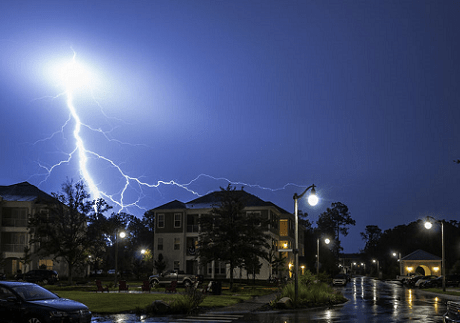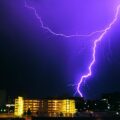Lightning is described as one of nature’s most powerful forces. Lightning can have devastating effects on people, property and trees. Each strike of lightning can reach more than five miles in length, and produce temperatures greater than 50,000 degrees Fahrenheit and an electrical charge of 100 million volts. At any given moment, there are 1,800 thunderstorms in progress somewhere across the earth. Lightning detection systems in the United States sense an average of 25 million lightning strikes per year.
About 240,000 incidents regarding lightning strikes happen globally each year. According to National Geographic, annually about 2,000 people are killed worldwide by lightning. It is one of the most common causes of weather-related deaths in the U.S. Lightning is a frequent occurrence worldwide with an estimated 50 occurrences per second and 20% of those resulting in ground strikes. SEE: What Attracts Lightning To A House

What Happens If Lightening Strikes Your House?
A lightning strike on a house discharges atmospheric electricity which is generated by an accumulation of differing charges within a cloud on the bulding. Each year lightning strikes cause billions of dollars in property damage and complete devastation. The following are the things that can happen when lightning strikes your house;
- Start a Fire. Lightning can start a direct fire because the core temperature of a lightning strike is approximately 50,000 degrees Fahrenheit. The harm to structures, electronics, building systems and vehicles can be extensive, causing loss of product and major downtime. The biggest threat lightning poses to a structure is fire. Wood and other flammable construction materials can easily explode when exposed to the high temperature of a lightning strike. Lightning current travelling through wires and pipelines instantly burns them up causing complete damage to property.
- Cause damage to electronics. Lightning is the single biggest cause of damage to and destruction of electrical and electronic equipment in industrial facilities, commercial buildings, and homes. If lightning chooses electrical wiring as its primary or secondary path, the explosive surge can damage all the appliances it is connected to. Most lightning strikes cause damage through the large current flowing in the return stroke or through the heat that is generated by this and the continuing current. A direct lightning strike will cause significant damage to electrical and nonelectrical items in the home. Moreover, electronics plugged into an electrical system that receives a direct lightning strike typically cannot be protected by a surge protector
- Strike a person. Lightning has the ability to strike a person inside a house and impart an electrical charge either through metal pipes used for plumbing or electrical appliance held appliances like phones or charging laptops. If lightning strikes a person, the stroke current can damage the central nervous system, heart, lungs, and other vital organs.
- Shock wave damage. Lightning produces shock waves that can be destructive. These shock waves can fracture concrete and brick and stone chimneys severely. To safeguard your structure from any type of lightning damage, it is essential to get a risk assessment done by lightning consultants so a carefully designed integrated lightning protection system can be installed as per the client’s need.






